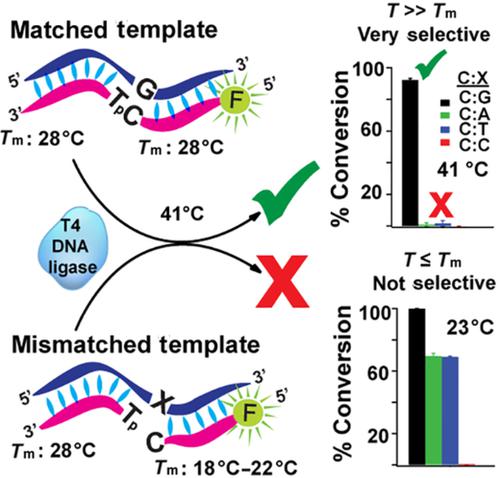当前位置:
X-MOL 学术
›
Biopolymers
›
论文详情
Our official English website, www.x-mol.net, welcomes your feedback! (Note: you will need to create a separate account there.)
Enhanced mismatch selectivity of T4 DNA ligase far above the probe: Target duplex dissociation temperature
Biopolymers ( IF 2.9 ) Pub Date : 2020-09-08 , DOI: 10.1002/bip.23393 Eiman A Osman 1 , B Safeenaz Alladin-Mustan 1 , Sarah C Hales 1 , Gunwant K Matharu 1 , Julianne M Gibbs 1
Biopolymers ( IF 2.9 ) Pub Date : 2020-09-08 , DOI: 10.1002/bip.23393 Eiman A Osman 1 , B Safeenaz Alladin-Mustan 1 , Sarah C Hales 1 , Gunwant K Matharu 1 , Julianne M Gibbs 1
Affiliation

|
T4 DNA ligase is a widely used ligase in many applications; yet in single nucleotide polymorphism analysis, it has been found generally lacking owing to its tendency to ligate mismatches quite efficiently. To address this lack of selectivity, we explored the effect of temperature on the selectivity of the ligase in discriminating single base pair mismatches at the 3′‐terminus of the ligating strand using short ligation probes (9‐mers). Remarkably, we observe outstanding selectivities when the assay temperature is increased to 7 °C to 13 °C above the dissociation temperature of the matched probe:target duplexes using commercially available enzyme at low concentration. Higher enzyme concentration shifts the temperature range to 13 °C to 19 °C above the probe:target dissociation temperatures. Finally, substituting the 5′‐phosphate terminus with an abasic nucleotide decreases the optimal temperature range to 7 °C to 10 °C above the matched probe:target duplex. We compare the temperature dependence of the T4 DNA ligase catalyzed ligation and a nonenzymatic ligation system to contrast the origin of their modes of selectivity. For the latter, temperatures above the probe:target duplex dissociation lead to lower ligation conversions even for the perfect matched system. This difference between the two ligation systems reveals the uniqueness of the T4 DNA ligase's ability to maintain excellent ligation yields for the matched system at elevated temperatures. Although our observations are consistent with previous mechanistic work on T4 DNA ligase, by mapping out the temperature dependence for different ligase concentrations and probe modifications, we identify simple strategies for introducing greater selectivity into SNP discrimination based on ligation yields.
中文翻译:

远高于探针的 T4 DNA 连接酶的错配选择性增强:目标双链体解离温度
T4 DNA 连接酶是许多应用中广泛使用的连接酶;然而,在单核苷酸多态性分析中,由于其非常有效地连接错配的倾向,已发现它普遍缺乏。为了解决这种缺乏选择性的问题,我们研究了温度对连接酶在使用短连接探针(9 聚体)区分连接链 3'-末端的单碱基对错配时的选择性的影响。值得注意的是,当测定温度升高到比匹配探针的解离温度高 7 °C 至 13 °C 时,我们观察到了出色的选择性:使用低浓度市售酶的目标双链体。较高的酶浓度将温度范围移至探针:目标解离温度以上 13 °C 至 19 °C。最后,用无碱基核苷酸取代 5'-磷酸末端将最佳温度范围降低至匹配探针:目标双链体上方 7°C 至 10°C。我们比较了 T4 DNA 连接酶催化连接和非酶连接系统的温度依赖性,以对比其选择性模式的起源。对于后者,即使对于完美匹配的系统,高于探针:目标双链体解离的温度也会导致较低的连接转化率。两种连接系统之间的这种差异揭示了 T4 DNA 连接酶在高温下为匹配系统保持出色连接产量的能力的独特性。尽管我们的观察结果与之前对 T4 DNA 连接酶的机制研究一致,但通过绘制不同连接酶浓度和探针修饰的温度依赖性,
更新日期:2020-09-08
中文翻译:

远高于探针的 T4 DNA 连接酶的错配选择性增强:目标双链体解离温度
T4 DNA 连接酶是许多应用中广泛使用的连接酶;然而,在单核苷酸多态性分析中,由于其非常有效地连接错配的倾向,已发现它普遍缺乏。为了解决这种缺乏选择性的问题,我们研究了温度对连接酶在使用短连接探针(9 聚体)区分连接链 3'-末端的单碱基对错配时的选择性的影响。值得注意的是,当测定温度升高到比匹配探针的解离温度高 7 °C 至 13 °C 时,我们观察到了出色的选择性:使用低浓度市售酶的目标双链体。较高的酶浓度将温度范围移至探针:目标解离温度以上 13 °C 至 19 °C。最后,用无碱基核苷酸取代 5'-磷酸末端将最佳温度范围降低至匹配探针:目标双链体上方 7°C 至 10°C。我们比较了 T4 DNA 连接酶催化连接和非酶连接系统的温度依赖性,以对比其选择性模式的起源。对于后者,即使对于完美匹配的系统,高于探针:目标双链体解离的温度也会导致较低的连接转化率。两种连接系统之间的这种差异揭示了 T4 DNA 连接酶在高温下为匹配系统保持出色连接产量的能力的独特性。尽管我们的观察结果与之前对 T4 DNA 连接酶的机制研究一致,但通过绘制不同连接酶浓度和探针修饰的温度依赖性,


























 京公网安备 11010802027423号
京公网安备 11010802027423号